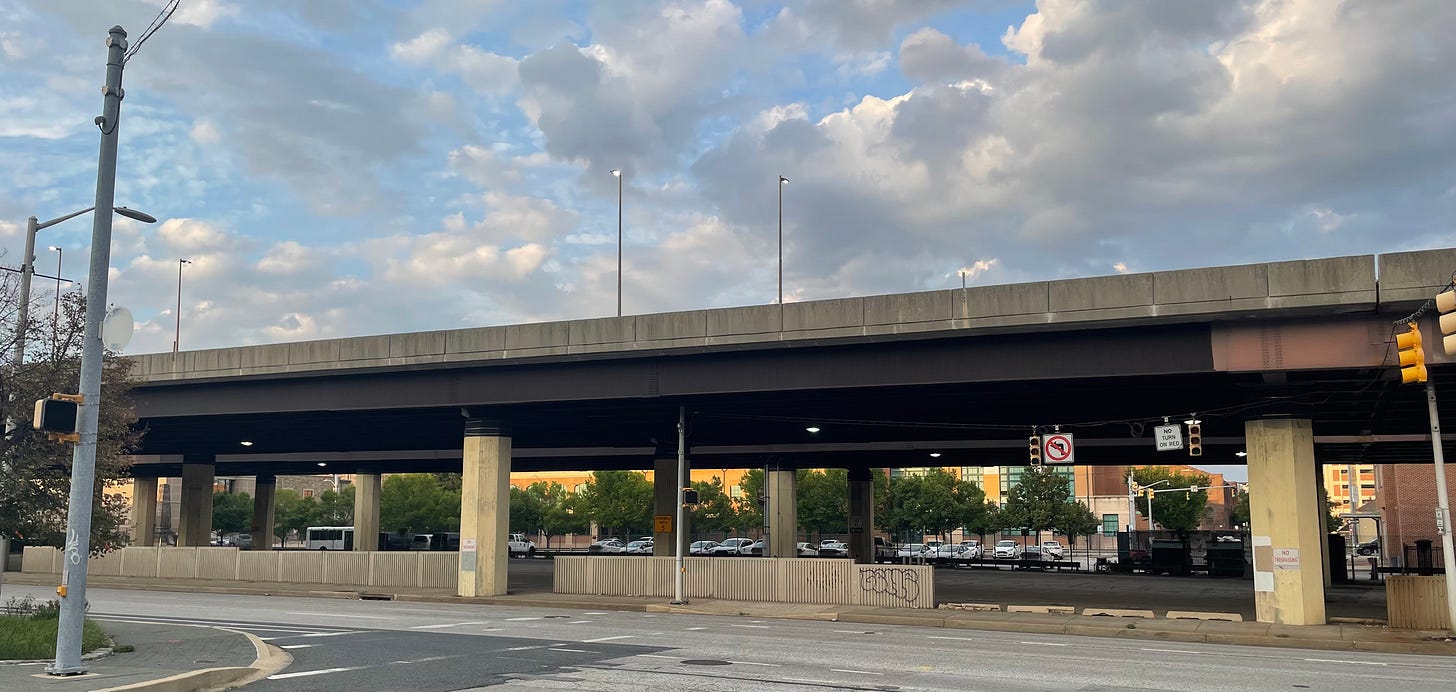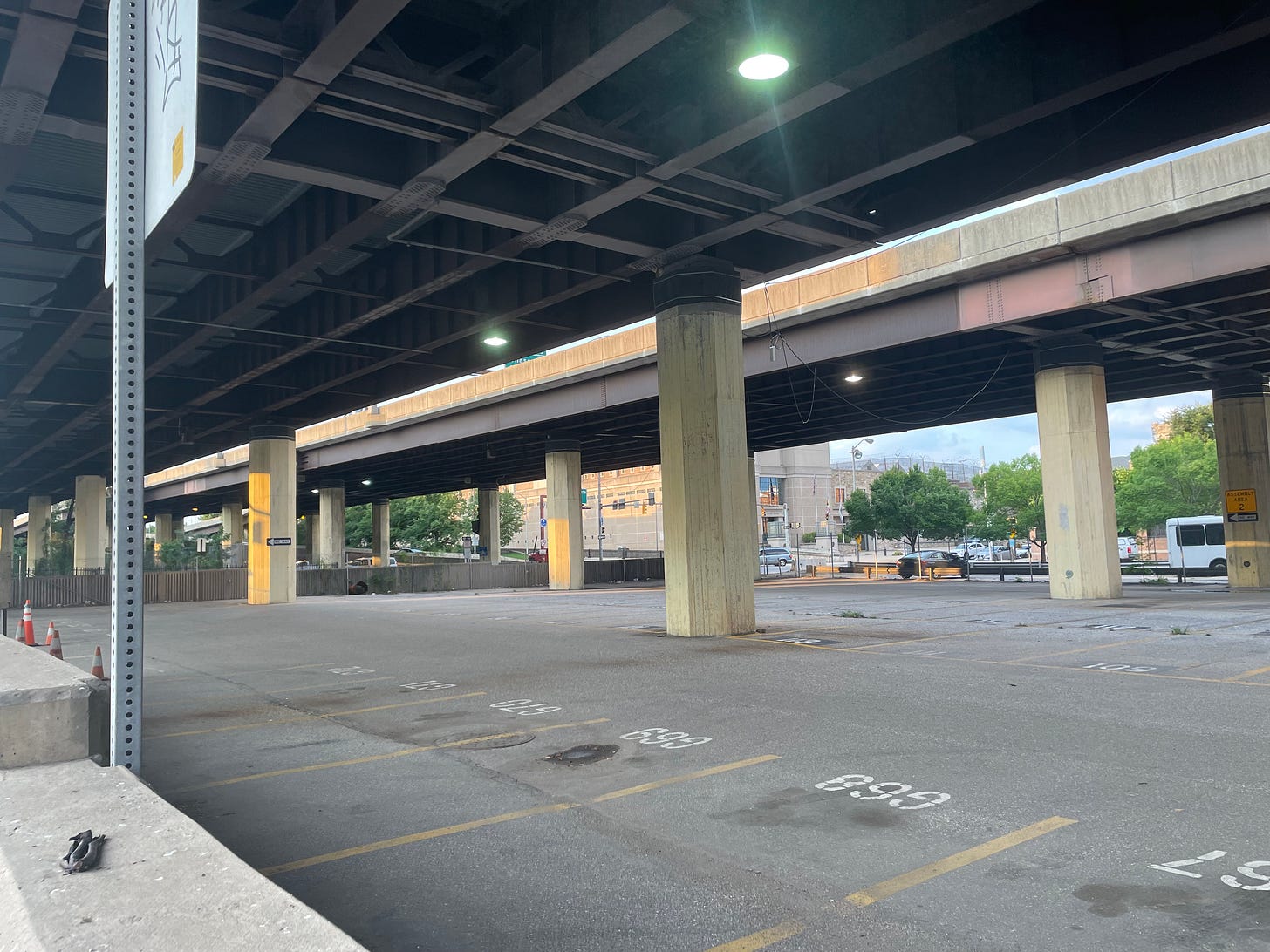An Urban Design Proposal for a JFX Viaduct Underpass Park
& the problem with "they should...."
“When are they going to do something about all this illegal dumping in my alley?”
“They should turn this into a park or playing fields.”
Or worst of all:
“Ugh, looks like they’re building some luxury apartments on this lot.”
The use of “they” isn’t necessarily bad or worthy of ridicule. The reason it’s annoying is because it can, at times, reveal a basic incomprehension of how land-use decisions are made and the multitude of stakeholders that there are, as well as an abdication of responsibility (and a transfer of blame) from the self to the powers that be.
Even a more positive, speculative use of “they,” in the context of suggesting a great idea for a particular under-utilized block in a city, is somehow grating to me, as necessary and useful as it may be to spitball and get outlandish ideas out in the open. There’s a particular tone and cadence to this that I can identify . . . I’ll take a stab at it:
idealist_bmore_resident1979
6 hours ago
They should turn Harborplace into a craft hub for local small businesses! Murals by local 3rd graders. Ferris wheel….dolphin rides……dirt-bike pump track.
2 likes Reply
A continual use of “they” in a more negative or suspicious manner can certainly be symptomatic of living through bad experiences with the all-powerful American government that upended cities and Black communities in the urban renewal era. This dynamic continues to this day (see Dan Blythewood’s Poppleton project).
But everyone — particularly those who don’t have the excuse of having been imposed upon by the government — has a responsibility to at least admit that they have a voice, however small. Speaking of “they” might identify something very real about the opaque, political element of development, but it also reflects apathy, and worse, incuriosity.
With that preface off my chest, I want to contradict myself and make a proposal for a particular under-utilized space. From this point on, I will move into the second-person in order to avoid being too much of a hypocrite, and will address YOU, civil servant of Baltimore City who may work at the DOT, DPW, BCRP, or Planning …. YOU, City Council member …. YOU, local design professional …. YOU, employee of a local foundation or economic development body, and, most importantly, YOU, local resident who may hold a surprising amount of influence over what your neighborhood looks like in a decade.
The Underpass Park
So, the Mount Vernon neighborhood is great and all. It has a mostly-uninterrupted urban fabric of handsome rowhouses and grand mansions, and is home to Mount Vernon Place, one of the world’s finest outdoor rooms.
A healthy district is one that perpetually evolves and improves. As nice as it is, Mount Vernon is mostly riding on its past glory, and is nowhere near meeting its potential. One-way arterial streets depress the pedestrian experience, and overly-restrictive historical preservation rules render implausible the infill projects that would help return the neighborhood’s anemic foot traffic to 1990s levels. As I’ve discussed with former housing commissioner and BDC chief Jay Brodie, Mount Vernon is in a weird position. It’s close enough to downtown to feel like it should be a more active market . . . but it’s far enough from downtown that it’s not a part of any central district that gets dedicated public space and streetscape capital improvements in the spirit of the public good.1
Topography is a real problem, too. The climb from downtown to Mount Vernon is just steep enough to be unpleasant, and the downward sweep of the neighborhood to the east towards the old, insalubrious swampland of the Jones Falls Valley and Central Booking is less fine-grained and more inhospitable than the higher-elevation areas.
Guilford Avenue, the eastern edge of Mount Vernon, lacks any activating attractions. Mount Vernon Market Center, a suburban-style strip mall developed in the ‘80s just after the fortress-like Mount Vernon Mews to the north, confirms Guilford Avenue as a car sewer rather than a pleasant place to walk. The JFX clatters and groans overhead. I do not walk down Guilford at night if I can help it.
Did I mention that Mount Vernon doesn’t have any recreational facilities?
Arriving finally at my proposal, city agencies and civic & private stakeholders, spurred on by active citizens, should work together to transform some of the parking lots underneath the JFX viaduct into recreational space — basketball and futsal courts (some with viewing areas), calisthenics equipment (a playground for adults), and whatever else. A city council bill will transfer ownership from whatever agency owns it at the moment to BCRP, redefine parking spots as necessary (there are plenty to go around in the Fallsway area), and allocate some amount of funding that will be supplemented by funding from other stakeholders. This initiative addresses a very real problem that erodes the attractiveness of Mount Vernon — a complete lack of space to run around, exercise, and play ball.
Lighting design, in tandem with increased foot traffic, would be the key elements for removing the well-earned sketchy stigma of this area. Drawing from the design principles of the Signal Station North project and the installation underneath the Gay Street railroad bridge, lighting will be intelligently and artfully deployed to make the JFX’s underbelly a place, rather than a void. It should be photogenic. It should show up in design magazines the world over. The foot traffic generated by such a project would make Guilford Avenue a destination, and would attract people from across the city. By closing the Pleasant Street off-ramp and narrowing cross-streets, the Underpass Park could be a linear park with running paths stretching all the way down to the Sunday Farmers Market. Guilford Avenue would receive a substantial road diet with concrete separated bike lanes. Stimulating connectivity between Mount Vernon and redevelopment in Oldtown is a huge uphill climb that will primarily consist of making the urban desert of Fallsway area pleasantly navigable for the average pedestrian or bicycle user, and this would be an excellent start.
The future of the JFX viaduct is an important consideration here. I very much hope that it will come down at some point and be replaced by new development, slow streets, and even a daylighted Jones Falls. But in the meantime, why not be proactive and act in the spirit of transitional, ephemeral urbanism?
It would not be right for an elected official to dismiss this idea by bringing up the potential of highway removal if you’ve never done anything to accelerate the dismantling of the JFX viaduct. The Underpass Park project could even increase interest in Marc Szarkowski’s Jones Falls Riviera idea by demonstrating that people will come east down the hill from Mount Vernon if and only if there is something to do. It would certainly increase the land value of parcels on the west side of Guilford Avenue, accelerating redevelopment of suburban uses into mixed-use projects with triple-paned windows. If I had a crystal ball and learned that the JFX would come down in 2032, I would be thrilled that it would happen so soon. Even in that best-case timeline of eight years, it would be worth it to build the Underpass Park attraction and operate it for about six years before the land transitions to a more intense use.
To conclude, THEY — I mean, YOU … and ME — should make this happen. I’m doing my part right now by getting it out into the world (even if that makes me a hypocrite). No, I do not have a conceptual map or sketch. I don’t even know which city agency owns those lots, or who exactly parks there. Please comment if you know! All I know is that people in Mount Vernon need a place to get their wiggles out, and that it’s possible to change the character of an area if you are sufficiently daring and proactive. People will put up with some overhead clattering if you give them a chance to exercise, meet friends to play around, and experience the city in a novel way.
Given that the idea of the downtown CBD is widely understood to be obsolete, the next step isn’t just to make downtown more livable (as noble of a goal that may be). There has to be a conceptual shift in what makes up the central district of Baltimore City. In a city of neighborhoods, this central district must be an exception from all inter-neighborhood sparring for funding. It will be a Commons that will be funded and planned to walkable and bike-able urban perfection, as a matter of the public good. The boundaries can be up for debate, but the catchment area must encompass some historically Black and white neighborhoods. Mid-rise is the best form of density, so we must capture and optimize the mid-rise neighborhoods around downtown. The downtown of 1950 (defined by the Downtown Management Authority Boundary) is not the right planning and improvement unit for a successful Baltimore City. Jay Brodie develops this idea in an April 2024 BBJ article.







Appreciate the kind words!